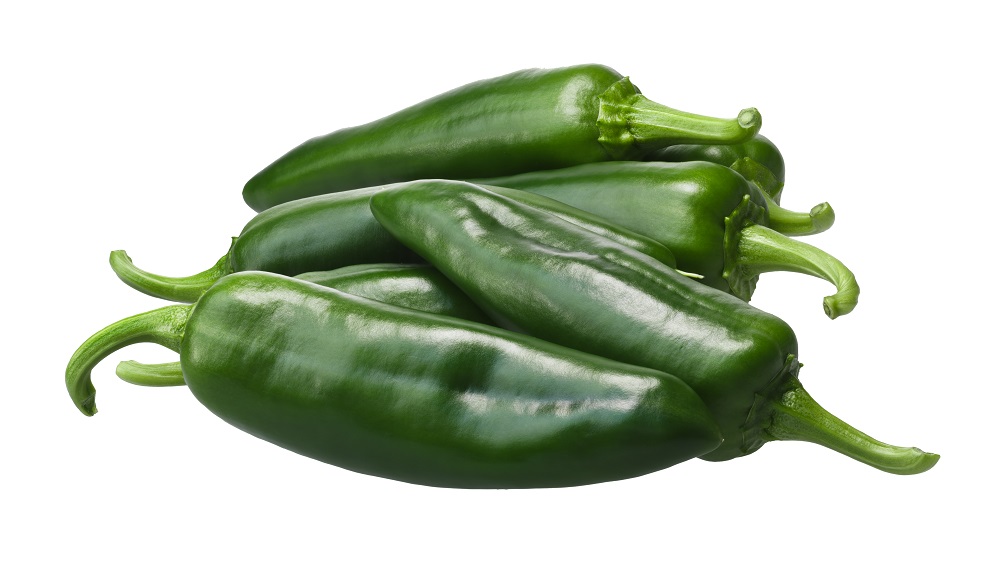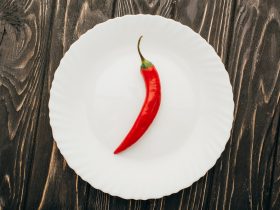Among one of the most commonly purchased types of chili pepper is the green chili, noted for its distinctly smoky and ever so sweet flavor that is accented by a head of spicy pungency rated at an approximate medium level of 25,000 to 100,000 units on the scoville scale.
Primarily used in a variety of cuisines as a spicy and pungent ingredient, green chilies may be substituted quite easily with a variety of other peppers or ingredients depending on the particular reason behind the requirement of substitution, with certain substitute ingredients being better suited for specific situations versus others.
The best flavor substitutes for green chilies are cayenne peppers, pablano peppers, and red chilies. Stronger spice substitutes for green chilies are habanero peppers and cheongyang chili peppers. Weaker spice substitutes for green chilies are jalapeno peppers, banana peppers, Anaheim pepper, and bell peppers.
Can Green Chilies be Substituted with a Weaker or Stronger Pepper?
In cases where the situation calls for a substitute pepper with a weaker or stronger pungency (spiciness), it is entirely possible to substitute green chilies with a variety of different capsicum possessing vegetables, with the particular level of pungency depending on the sort of species used.

This is especially important in instances where an individual may have some sort of gastric condition that is aggravated by the presence of too pungent a spicy ingredient, requiring a significantly weaker or otherwise non-spicy substitute be used in the recipe.
Flavor Substitutes for Green Chilies
Presenting a distinctly smoky and full bodied flavor with light notes of sweetness that are characteristic of the chili pepper family, green chilies are said to pair quite well with dairy products and acidic ingredients that not only temper the green chili pepper’s heat but also pair quite well with its otherwise earthy flavor.
Fortunately, several other types of peppers share these characteristics with the green chili pepper itself, being able to pair with much the same ingredients that green chili would normally be added alongside.
Cayenne Peppers
More often seen in their powdered and dried form wherein they are used as a seasoning instead of a vegetable, cayenne peppers are an excellent substitute for green chiles owing to the similarly earthy and somewhat smoky flavor that they share, with raw notes of acridness if treated in the correct manner.
However, cayenne peppers are considered quite spicy, being in the upper echelon of commercially available pungent peppers, and as such may require a significantly smaller volume if being used as a substitute to green chilies.
This is, of course, not entirely applicable if the consumer of the meal rather enjoys a spicier flavor profile.
Otherwise, it is possible to instead temper the cayenne pepper’s pungency through the use of dairy products and acidic ingredients that help dilute its relative spiciness.
Poblano Peppers
Similarly popular in Mexican and American cuisines, the poblano pepper is a fleshy and green vegetable with a somewhat lower level of pungency than most other peppers, especially that of the green chili.

The poblano pepper and the green chili pepper both share a distinctly earthy and somewhat smoky flavor that presents itself with a full body alongside mild notes of sweetness in the aftertaste, with the primary difference between the two being the poblano pepper’s somewhat stronger smokey flavor, especially if roasted prior to usage.
Appearance-wise, the poblano pepper is also quite similar to the green chili pepper, with the only main distinction being that the poblano pepper is significantly larger in size, making it less suitable for certain dishes like fried rice or tacos without first being processed.
Red Chilies
Simply the aged and more matured version of green chili peppers, red chili peppers share the vast majority of the body of flavors normally found in green chili peppers, with the same distinct acridness and smokiness that make green chili peppers so popular in sauces or as a roasted vegetable.
However, due to the maturity of red chili peppers, a more distinct sweetness may also take its place in the pepper’s flavor profile, making red chili peppers better suited for certain recipes that could benefit from a stronger presence of sweetness, such as in salsas or certain stews.
Stronger Spiciness Substitutes for Green Chilies
If the primary reason for substituting green chilies is the fact that they do not produce enough of a pungent effect, certain other types of peppers may possess a stronger level of spiciness, while occasionally retaining similar flavors and textures that allow them to act as excellent substitutes for green chili peppers.
Considering the fact that green chili peppers are considered highly variable in spiciness depending on the particular species of green chili pepper used, it may be advisable for the chef to look up the specific scoville level of their particular green chili pepper species so as to gauge how much stronger an alternative ingredient would be in terms of pungency.
Habanero Peppers
Different from a visual standpoint in comparison to green chili peppers, the habanero pepper is tangentially related to the chili family with a significantly stronger level of pungency, especially in its more mature form with the seeds being incorporated into the recipe.

Having an approximate scoville scale rating of 100,000 to 350,000, the habanero pepper can be anywhere from twice to six times as strong as a green chili pepper would be in terms of spiciness.
It is our advice to first incorporate only a small amount of habanero pepper into a recipe that originally intends to use the green chili pepper, as too much habanero added to a dish can easily overpower any other flavors present, potentially ruining the flavor profile.
Cheongyang Chili Peppers
A popular species of chili pepper in Korean cuisines and other southeast Asian cultures, the cheongyang chili pepper often presents a light purple to green color prior to harvesting if immature, making it visually distinct from the green chili pepper.
In terms of pungency, the cheongyang chili pepper rates at an approximate 10,000 scoville units, making it stronger than most of the weaker varieties of green chili pepper while still remaining at a reasonable and somewhat tolerable level.
This has the added benefit of allowing the cheongyang chili pepper to be used in similar volumes to the green chili pepper without overpowering the relative flavor profile of the dish.
Weaker Spiciness Substitutes for Green Chilies
If, instead of requiring a more pungent substitute be found for green chili peppers, it is entirely possible to instead use a variety of different peppers, all of which possess a somewhat weaker level of spiciness than green chili peppers themselves.
It is important to remember, however, that most of these weaker substitutes to green chili peppers still possess some level of spiciness, and as such may not be suitable for individuals that possess medical conditions or personal preferences against the presence of any sort of spicy ingredient.
Jalapeno Peppers
Fleshy, usually consumed while still immature and green, the jalapeno pepper is perhaps one of the few peppers that can rival the popularity of the green chili pepper itself, with certain cultivars being used as a direct green chili pepper substitute in instances where the spiciness of green chili is too strong for the recipe.

With an average scoville rating of 3,500 to 8,000, the jalapeno pepper is moderately weaker than the green chili pepper, making it an excellent substitute for situations wherein some level of spiciness is required while remaining weaker than what would normally be imparted by the green chili pepper.
Banana Peppers
Also referred to as the yellow wax chili, banana peppers are an extremely mild pepper with a somewhat sour and slightly sweet taste and practically no presence of spiciness, oftentimes rating at a zero to 500 on the scoville scale, making the banana pepper excellent as a weaker spiciness substitute to the green chili pepper.
The banana pepper truly shines as a green chili pepper substitute in instances wherein some sort of pepper must be added to the recipe without the addition of any sort of spiciness, though dried and ripened banana peppers may still present some miniscule level of pungency in comparison to its younger and fresher variant.
Anaheim Pepper
A close cousin and variety of green chili pepper, the Anaheim pepper originates from the American state of California, with an average scoville rating of anywhere between 500 to 2,500, making it at most one-fourth as strong as certain other species of green chili pepper.
Being so similar to most species of the green chili pepper, the Anaheim pepper shares a large majority of the flavor notes that would normally be found in the latter vegetable, making it excellent for usage in a one to one ratio for recipes that require a somewhat weaker pungency pepper.
Bell Peppers
The quintessential zero pungency pepper, bell peppers may be used in instances where the general flavor and appearance of a green chili pepper is required without any sort of spiciness being present, such as in the case of the meal’s consumer possessing some sort of gastric condition.
Bell peppers are rather unsuitable in terms of an exact flavor replacement for green chili peppers due to the fact that they possess little in the way of smokiness or acridity without prior smoking or roasting, as well as the fact that their relative sweetness is somewhat stronger than what would normally be imparted by green chili peppers.
References
1. Macho, Antonio; Lucena, Concepción; Sancho, Rocio; Daddario, Nives; Minassi, Alberto; Muñoz, Eduardo; Appendino, Giovanni (1 February 2003). “Non-pungent capsaicinoids from sweet pepper”. European Journal of Nutrition. 42 (1): 2–9. doi:10.1007/s00394-003-0394-6. ISSN 1436-6207. PMID 12594536.
2. Batiha GE, Alqahtani A, Ojo OA, Shaheen HM, Wasef L, Elzeiny M, Ismail M, Shalaby M, Murata T, Zaragoza-Bastida A, Rivero-Perez N, Magdy Beshbishy A, Kasozi KI, Jeandet P, Hetta HF. Biological Properties, Bioactive Constituents, and Pharmacokinetics of Some Capsicum spp. and Capsaicinoids. Int J Mol Sci. 2020 Jul 22;21(15):5179. doi: 10.3390/ijms21155179. PMID: 32707790; PMCID: PMC7432674.
3. Dave DeWitt and Paul W. Bosland (2009). The Complete Chile Pepper Book: A Gardener’s Guide to Choosing, Growing, Preserving, and Cooking. Timber Press. ISBN 978-0881929201.





Hi, I'm Dom
Dom Eats was started to help other people fall in love with food. While cooking can feel intimidating, it doesn't have to be.